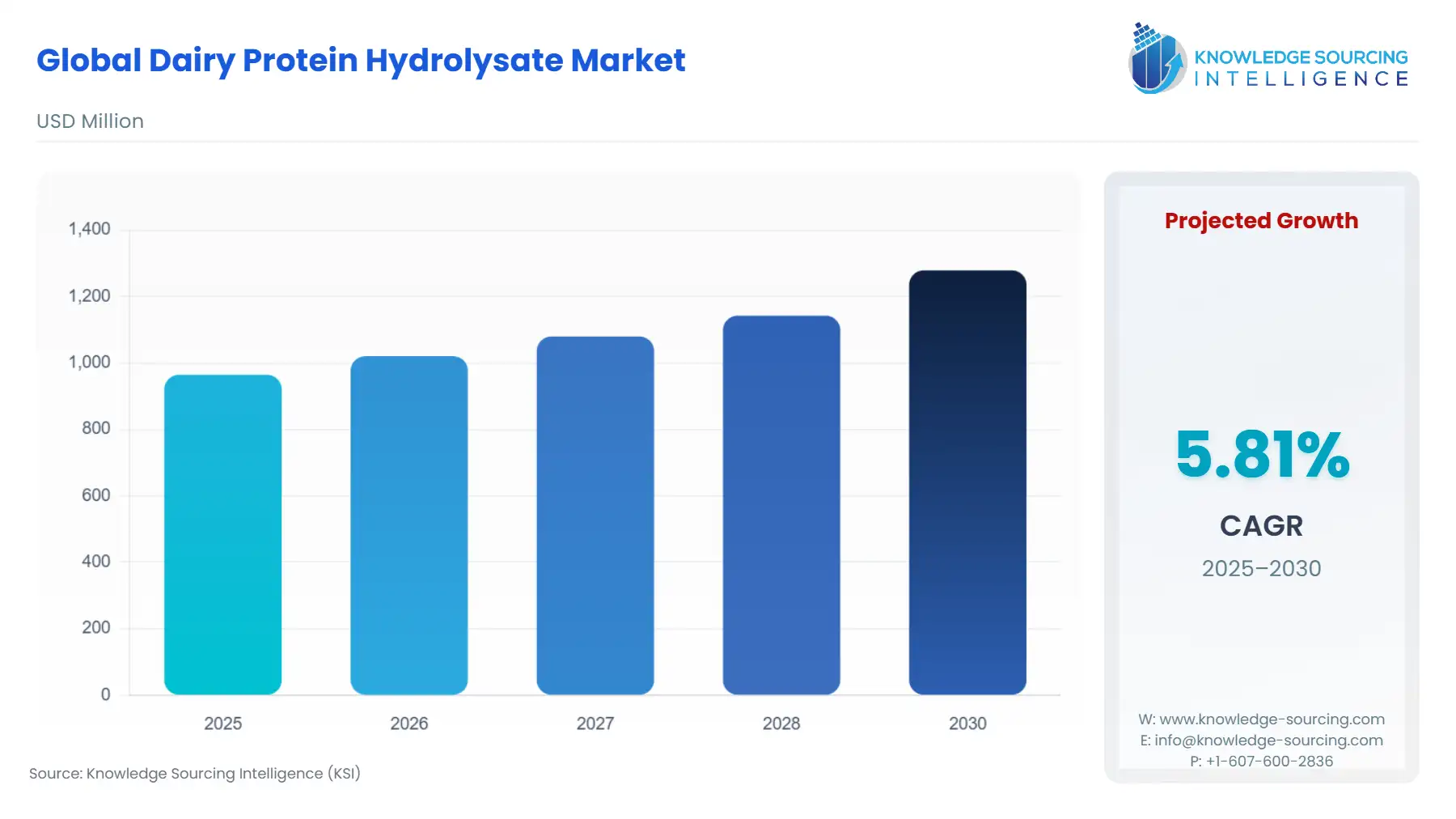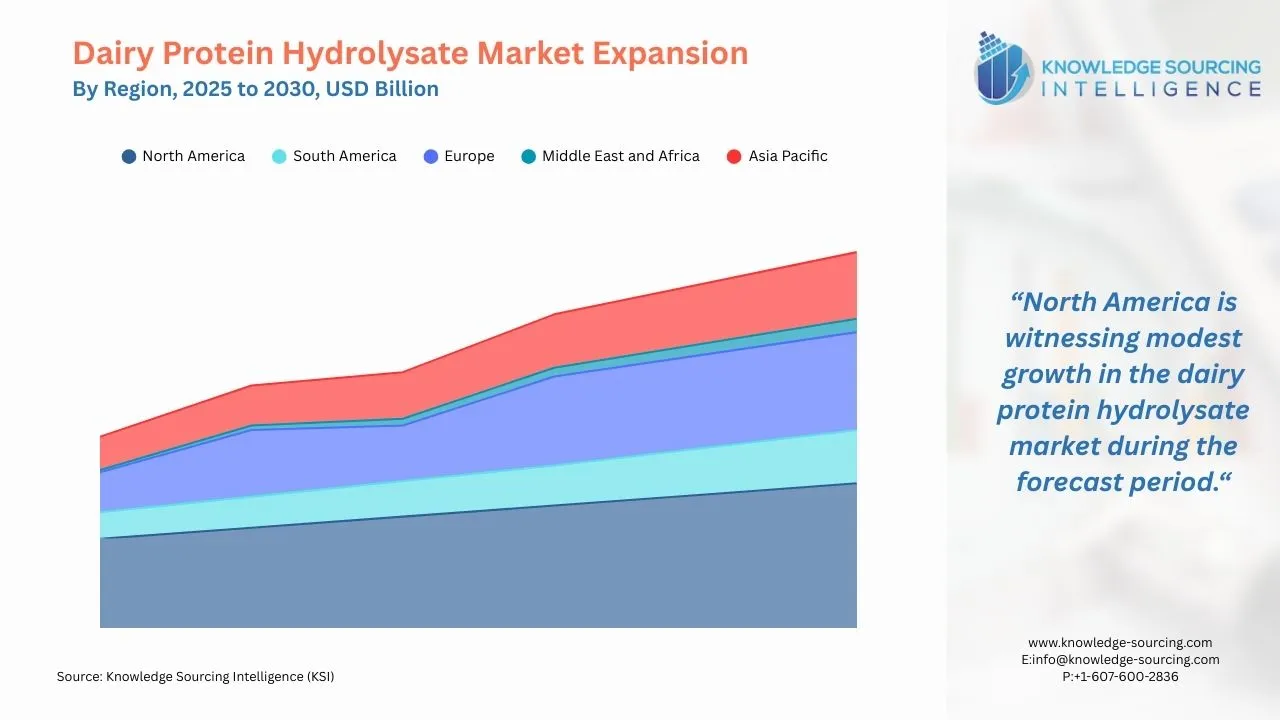Global Dairy Protein Hydrolysate Market Size, Share, Opportunities, And Trends By Product (Whey, Casein), By Form (Powder, Paste), Technology (Acid Hydrolysis, Enzymatic Hydrolysis), By Application (Sports & Nutrition, Infant Nutrition, Clinical Nutrition, Animal Feed), And By Geography - Forecasts From 2025 To 2030
Description
Dairy Protein Hydrolysate Market Size
The Global Dairy Protein Hydrolysate Market is expected to grow at a CAGR of 5.81%, reaching a market size of US$1278.97 million in 2030 from US$964.552 million in 2025.
Dairy Protein Hydrolysate Market Key Highlights:
- Growing consumer demand is boosting the dairy protein hydrolysate market globally.
- Increasing health awareness is driving nutritional supplement use, including hydrolysates.
- Rising infant nutrition needs are fueling demand for dairy protein hydrolysates.
- Whey protein dominance is continuing due to its fast absorption and wide applications.
Dairy protein hydrolysate is a protein extracted from milk that has been hydrolyzed, i.e., a protein consisting of highly organized chains of amino acids broken down into simpler and smaller chains called peptides. So, it is a milk-derived protein formed through hydrolysis, and it is tailored to specific applications, functions, and different markets.

To learn more about this report, request a free sample copy
Numerous factors are driving the market growth of dairy protein hydrolysate. Consumers are becoming more health-conscious, demanding various nutritional products that can help them in bridging the nutritional deficiency. This increase in demand for dairy protein hydrolysate is also positively impacted by the growth of consumers' disposable income. At the same time, the rising demand for infant nutrition is leading the market growth of dairy protein hydrolysate. Moreover, the benefits offered by dairy protein through the process of hydrolysis, like a faster absorption rate than intact protein as it is tailored to specific requirements, is leveraging dairy protein hydrolysate demand in infants, athletes, elderly people, and fitness enthusiasts’ consumers.
The global dairy protein hydrolysate market has been classified based on product, form, technology, application, and geography. Based on the product, the market has been segmented into whey protein and casein, with whey protein having the largest share in the global dairy protein hydrolysate market. Based on form, the global dairy protein hydrolysate market has been segmented into powder and paste, dominated by powder form due to its convenience and other reasons. The global dairy protein hydrolysate market has been bifurcated by technology into acid hydrolysis and enzymatic hydrolysis. By application, the global market has been classified as sports nutrition, infant nutrition, clinical nutrition, and animal feed. The market is segmented into five key regions of the world- Asia-Pacific, North America, South America, Europe, and the Middle East.
Diary Protein Hydrolysate Market Growth Drivers:
- The growing demand by the infant segment will be driving the market growth
There is an increasing demand for nutritional food by the infant segment of the market. The rising number of women in the working population is increasing the dependence on ready-made nutritional food for infants. This is leading to an increase in demand for dairy protein hydrolysate of milk formula.
- Rising health awareness among the population is increasing the demand for nutritional supplements
Growing awareness among people regarding the consumption of nutritional products is significantly driving the demand for dairy protein hydrolysates globally.
The rising prevalence of chronic diseases such as obesity and diabetes is encouraging people to focus on their lifestyle choices and dietary patterns. At the same time, to fulfill their protein requirement, people are using hydrolysate protein formula, leading to an increase in demand for dairy protein hydrolysate.
Diary Protein Hydrolysate Market Segmentation Analysis:
- Whey Protein type will continue to hold a major market share
The dairy protein hydrolysate market is segmented into Whey protein and Casein protein. During the forecast period, whey protein will continue to dominate the market share based on type.

Whey protein is a form of high-quality protein derived from that part of milk. Whey is the remaining liquid left after milk has been strained. It is a by-product of the cheese manufacturing process. Whey protein is dominating the market share of dairy protein hydrolysate for many reasons. It has wide applications as it has a faster absorption rate than casein. The constituent profile of whey protein contains all the nine essential amino acids the body requires. It is more widely available than the Casein protein, which has a very limited market share. Hence, in the forecast period, whey protein will continue to dominate the market share.
Dairy Protein Hydrolysate Market Geographical Outlook:
- North America will continue to hold the largest share in the forecast period.
Geographically, the global dairy protein hydrolysate market is classified into five major regional markets- North America, South America, Europe, the Middle East and Africa (MEA), and Asia Pacific (APAC).

North America accounted for a significant global dairy protein hydrolysate market share. The growth of this regional market is attributed to rising demand across the United States and Canada. Increasing health awareness among people in this region and shifting consumer preference towards nutritional products to maintain overall health and well-being is boosting the North American dairy protein hydrolysates market. High demand for energy bars and energy shakes across restaurants and homes to promote fat loss and weight management is further contributing to the regional market expansion. Asia Pacific is projected to experience a significant growth rate (CAGR) during the forecast period.
Diary Protein Hydrolysate Market Restraints:
- Regulatory and compliance policies can hinder market growth
Though the demand for dairy protein hydrolysate is showing an increasing trend, the regulatory and compliance challenges put forth by different governments to meet the health and safety standards will be acting as key restraints in the market expansion as it will increase the cost of product development, affecting the price-sensitive customers.
Diary Protein Hydrolysate Market Key Developments:
- In November 2024, Arla Foods Ingredients, a global company in premium nutrition, acquired Volac’s Whey Nutrition Business. Arla Foods Ingredients is building a processing facility at Felinfach in Wales to produce whey protein.
- In November 2024, Valio, a leading Finnish dairy company, launched a new product segment- milk protein concentrate Valio Elis MPC® 65 in the protein products market.
- In October 2024, FrieslandCampina Ingredients, a global protein and probiotic specialist, announced that its new protein hydrolysate ingredient “Hyvital Whey HA 300” has been approved by the EU for its use across European Union countries for infants and follow-on formulas.
List of Top Dairy Protein Hydrolysate Companies:
- AMCO Proteins
- Milk Specialties Global
- Agropur Inc.
- Glanbia Nutritionals Inc.
- Hilmar Cheese Company
Dairy Protein Hydrolysate Market Scope:
| Report Metric | Details |
| Dairy Protein Hydrolysate Market Size in 2025 | US$964.552 million |
| Dairy Protein Hydrolysate Market Size in 2030 | US$1278.97 million |
| Growth Rate | CAGR of 5.81% |
| Study Period | 2020 to 2030 |
| Historical Data | 2020 to 2023 |
| Base Year | 2024 |
| Forecast Period | 2025 – 2030 |
| Forecast Unit (Value) | USD Million |
| Segmentation |
|
| Geographical Segmentation | North America, South America, Europe, Middle East and Africa, Asia Pacific |
| List of Major Companies in the Dairy Protein Hydrolysate Market |
|
| Customization Scope | Free report customization with purchase |
The Global Diary Protein Hydrolysate market is segmented and analyzed as follows:
- By Type
- Whey
- Casein
- By Form
- Powder
- Paste
- By Application
- Sports Nutrition
- Infant Nutrition
- Clinical Nutrition
- Animal Feed
- By Geography
- North America
- United States
- Canada
- Mexico
- South America
- Brazil
- Argentina
- Others
- Europe
- UK
- Germany
- France
- Italy
- Others
- Middle East and Africa
- Saudi Arabia
- Israel
- Others
- Asia Pacific
- Japan
- China
- India
- South Korea
- Indonesia
- Thailand
- Others
- North America
Our Best-Performing Industry Reports:
Frequently Asked Questions (FAQs)
The dairy protein hydrolysate market is expected to reach a total market size of US$1278.97 million by 2030.
Dairy Protein Hydrolysate Market is valued at US$964.552 million in 2025.
The global dairy protein hydrolysate market is expected to grow at a CAGR of 5.81% during the forecast period.
Growing awareness among people regarding the consumption of nutritional products is significantly driving the demand for dairy protein hydrolysates globally.
North America accounted for a significant share of the global dairy protein hydrolysate market owing to growing demand across the United States and Canada.
Table Of Contents
1. INTRODUCTION
1.1. Market Overview
1.2. Market Definition
1.3. Scope of the Study
1.4. Market Segmentation
1.5. Currency
1.6. Assumptions
1.7. Base and Forecast Years Timeline
1.8. Key Benefits for the Stakeholders
2. RESEARCH METHODOLOGY
2.1. Research Design
2.2. Research Process
3. EXECUTIVE SUMMARY
3.1. Key Findings
3.2. Analyst View
4. MARKET DYNAMICS
4.1. Market Drivers
4.2. Market Restraints
4.3. Porter’s Five Forces Analysis
4.3.1. Bargaining Power of Supplier
4.3.2. Bargaining Power of Buyers
4.3.3. The Threat of New Entrants
4.3.4. Threat of Substitutes
4.3.5. Competitive Rivalry in the Industry
4.4. Industry Value Chain Analysis
5. GLOBAL DAIRY PROTEIN HYDROLYSATE BY TYPE
5.1. Introduction
5.2. Whey
5.3. Casein
6. GLOBAL DAIRY PROTEIN HYDROLYSATE BY FORM
6.1. Introduction
6.2. Powder
6.3. Paste
7. GLOBAL DAIRY PROTEIN HYDROLYSATE BY APPLICATION
7.1. Introduction
7.2. Sports Nutrition
7.3. Infant Nutrition
7.4. Clinical Nutrition
7.5. Animal Feed
8. GLOBAL DAIRY PROTEIN HYDROLYSATE BY GEOGRAPHY
8.1. Introduction
8.2. North America
8.2.1. United States
8.2.2. Canada
8.2.3. Mexico
8.3. South America
8.3.1. Brazil
8.3.2. Argentina
8.3.3. Others
8.4. Europe
8.4.1. UK
8.4.2. Germany
8.4.3. France
8.4.4. Italy
8.4.5. Others
8.5. Middle East and Africa
8.5.1. Saudi Arabia
8.5.2. Israel
8.5.3. Others
8.6. Asia Pacific
8.6.1. Japan
8.6.2. China
8.6.3. India
8.6.4. South Korea
8.6.5. Indonesia
8.6.6. Thailand
8.6.7. Others
9. COMPETITIVE ENVIRONMENT AND ANALYSIS
9.1. Major Players and Strategy Analysis
9.2. Market Share Analysis
9.3. Mergers, Acquisitions, Agreements, and Collaborations
9.4. Competitive Dashboard
10. COMPANY PROFILES
10.1. AMCO Proteins
10.2. Milk Specialties Global
10.3. Agropur Inc.
10.4. Glanbia Nutritionals Inc.
10.5. Hilmar Cheese Company
10.6. Kerry Group plc
10.7. Titan Biotec
10.8. Arla Foods Ingredients Group P/S
10.9. Ingredia
10.10. Armor Proteins
10.11. A. Costantino & C. spa
10.12. Hyprol Protein Hydrolysates
10.13. FrieslandCampina Ingredients
10.14. NZMP
10.15. Hofseth BioCare ASA
Companies Profiled
AMCO Proteins
Milk Specialties Global
Agropur Inc.
Glanbia Nutritionals Inc.
Hilmar Cheese Company
Kerry Group plc
Titan Biotec
Arla Foods Ingredients Group P/S
Ingredia
Armor Proteins
A. Costantino & C. spa
Hyprol Protein Hydrolysates
FrieslandCampina Ingredients
NZMP
Hofseth BioCare ASA
Related Reports
| Report Name | Published Month | Download Sample |
|---|---|---|
| Animal Protein Ingredients Market: Size, Trends, Forecast 2030 | December 2025 | |
| Whey Protein Ingredients Market: Trends, Forecast 2025-2030 | August 2025 | |
| Infant Formula Market: Growth, Trends, Forecast 2025-2030 | April 2025 | |
| Dairy Ingredients Market Report: Trends, Growth, Forecast 2030 | December 2024 | |
| Protein Ingredients Market Report: Size, Share, Forecast 2030 | December 2024 |